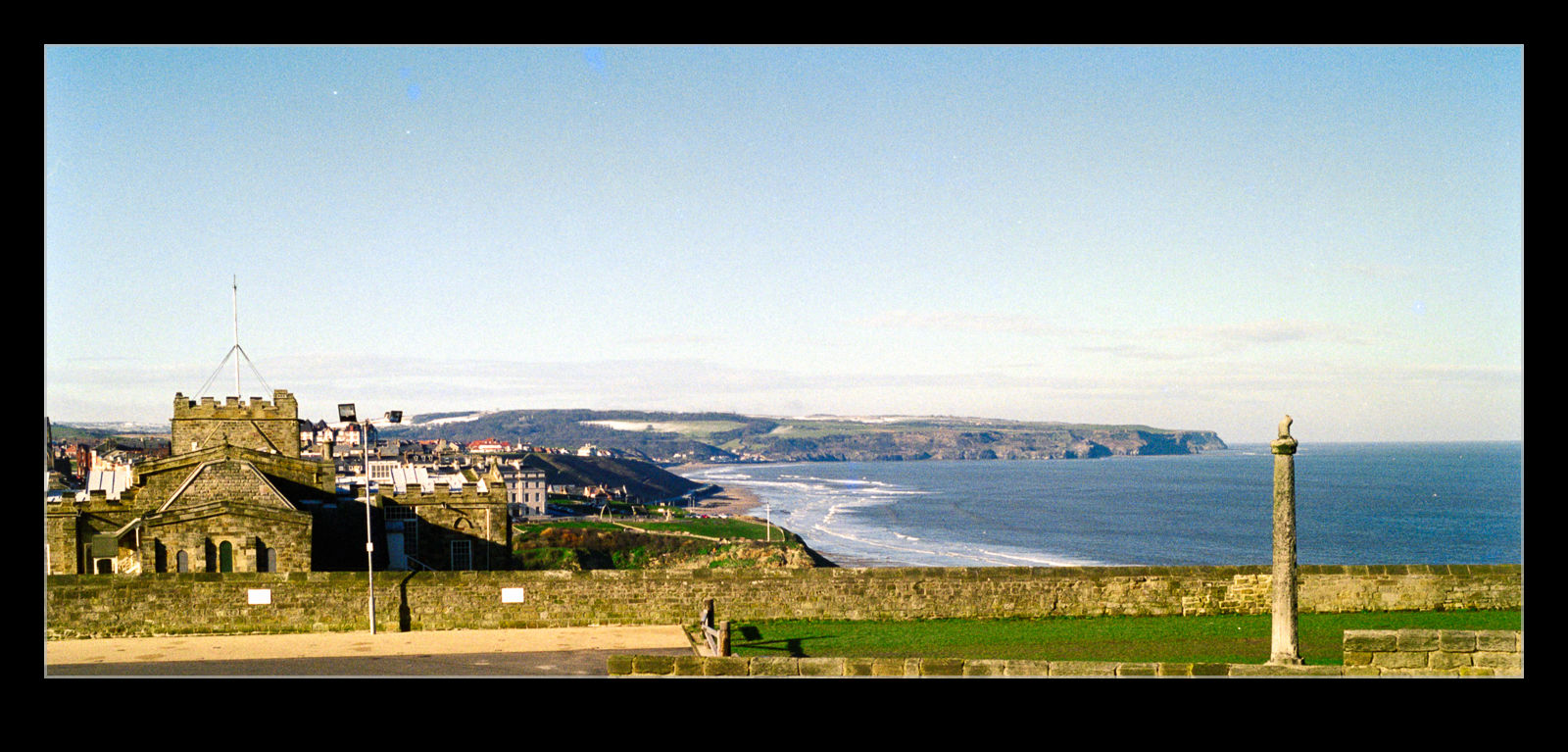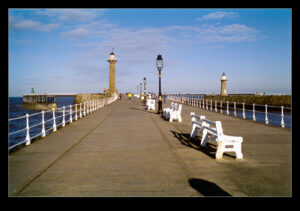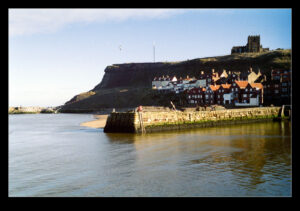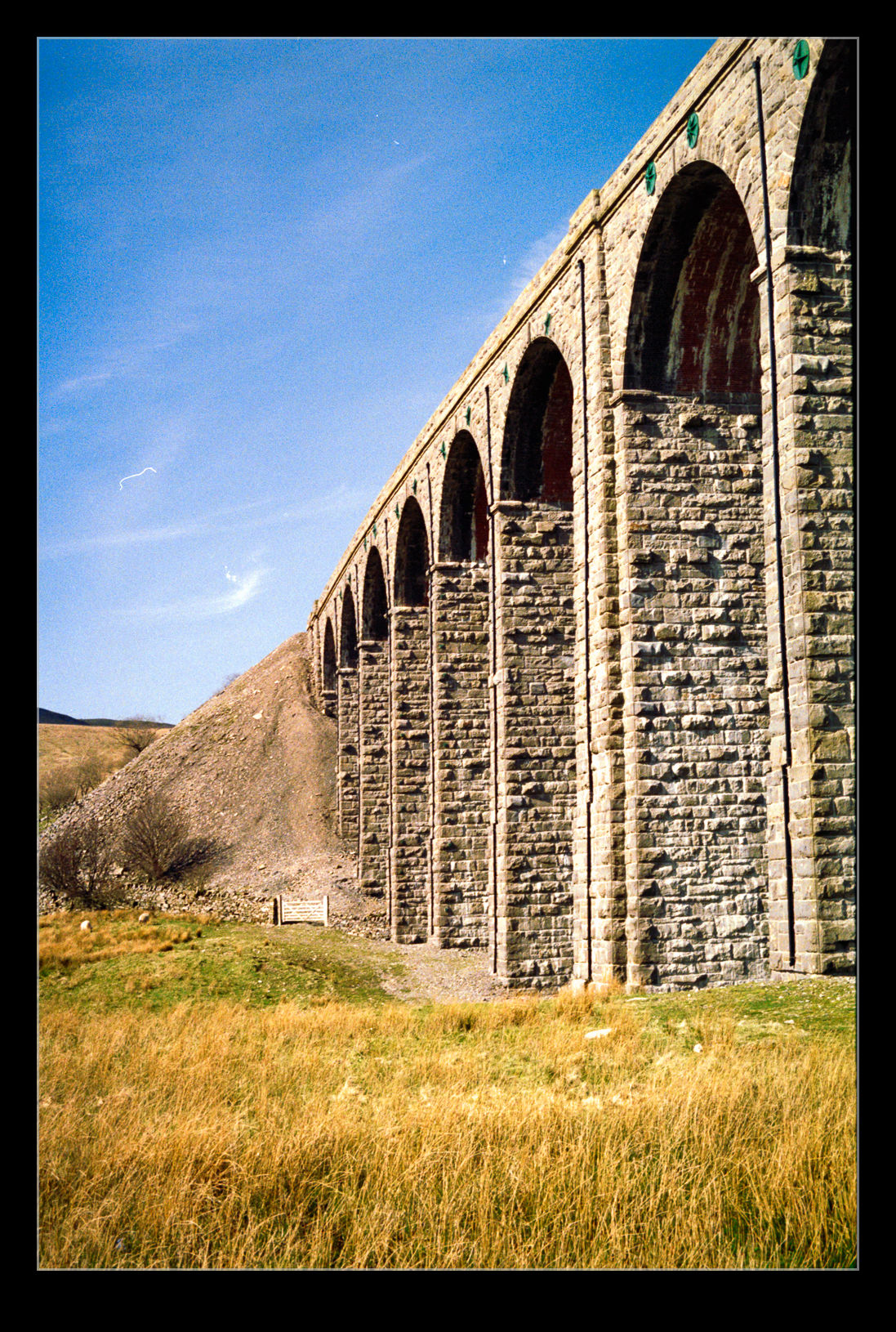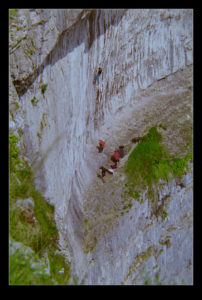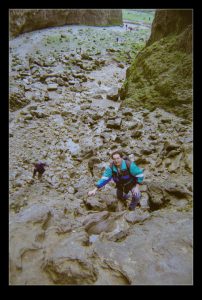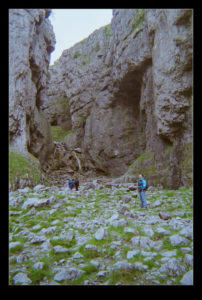 A Ladybird Book reference in the title for some of you of a certain age from a certain country. An exhibit at the National Railway Museum in York is a sectioned steam locomotive. One of the guides at the museum showed us the various stages of the process of turning coal and water into power for the loco. I hadn’t understood the process fully before (and probably still need some additional education to be honest) but having the side of the loco cut open to show the various processes and the flow of the steam really made it easier to understand. I was going to say visualise, but it isn’t really visualising when you are looking right at it!
A Ladybird Book reference in the title for some of you of a certain age from a certain country. An exhibit at the National Railway Museum in York is a sectioned steam locomotive. One of the guides at the museum showed us the various stages of the process of turning coal and water into power for the loco. I hadn’t understood the process fully before (and probably still need some additional education to be honest) but having the side of the loco cut open to show the various processes and the flow of the steam really made it easier to understand. I was going to say visualise, but it isn’t really visualising when you are looking right at it!
Tag Archives: Yorkshire
National Railway Museum
 I was fortunate a little while ago to have a tour of the National Railway Museum. Our company had sponsored some of the development at the museum and we were invited to come and see some of the parts of the museum that are normally out of sight to the regular visitors. This was a most interesting visit, and our team really appreciated the time there. This was actually the first time I had been to this excellent museum.
I was fortunate a little while ago to have a tour of the National Railway Museum. Our company had sponsored some of the development at the museum and we were invited to come and see some of the parts of the museum that are normally out of sight to the regular visitors. This was a most interesting visit, and our team really appreciated the time there. This was actually the first time I had been to this excellent museum.
 As part of the Science Museum, the National Railway Museum is free to the public. They are expanding the facilities a lot currently but, if you were to visit now, you would still have plenty to see. There are trains of all types and age. The main hall is focused on a turntable. Apparently, the collection does get moved regularly so what you see at any one time can vary.
As part of the Science Museum, the National Railway Museum is free to the public. They are expanding the facilities a lot currently but, if you were to visit now, you would still have plenty to see. There are trains of all types and age. The main hall is focused on a turntable. Apparently, the collection does get moved regularly so what you see at any one time can vary.
 The majority of the collection is UK trains but there are other exhibits. A series 0 Shinkansen is part of the collection. Additionally, there is a Eurostar cab vehicle. Some famous locos are there, like Mallard, holder of the steam speed record. There are other less famous ones like the last steam loco built for the UK. I liked seeing the HST power car having had a lot of involvement with that fleet earlier in my career.
The majority of the collection is UK trains but there are other exhibits. A series 0 Shinkansen is part of the collection. Additionally, there is a Eurostar cab vehicle. Some famous locos are there, like Mallard, holder of the steam speed record. There are other less famous ones like the last steam loco built for the UK. I liked seeing the HST power car having had a lot of involvement with that fleet earlier in my career.
 There are many artefacts aside from the trains. The gates that used to be at Euston station are most impressive. The nameplates from many locomotives are on the wall. There are two nameplates from Earl of Mount Edgcumbe which made me smile. My time around the main collection was slightly limited by other work commitments and, ultimately, the need to get on a train to Derby. After so long having never visited, I am really pleased to have finally made it there. If you are looking for a day trip in the area, do consider it. It is a short walk from the station.
There are many artefacts aside from the trains. The gates that used to be at Euston station are most impressive. The nameplates from many locomotives are on the wall. There are two nameplates from Earl of Mount Edgcumbe which made me smile. My time around the main collection was slightly limited by other work commitments and, ultimately, the need to get on a train to Derby. After so long having never visited, I am really pleased to have finally made it there. If you are looking for a day trip in the area, do consider it. It is a short walk from the station.
Whitby
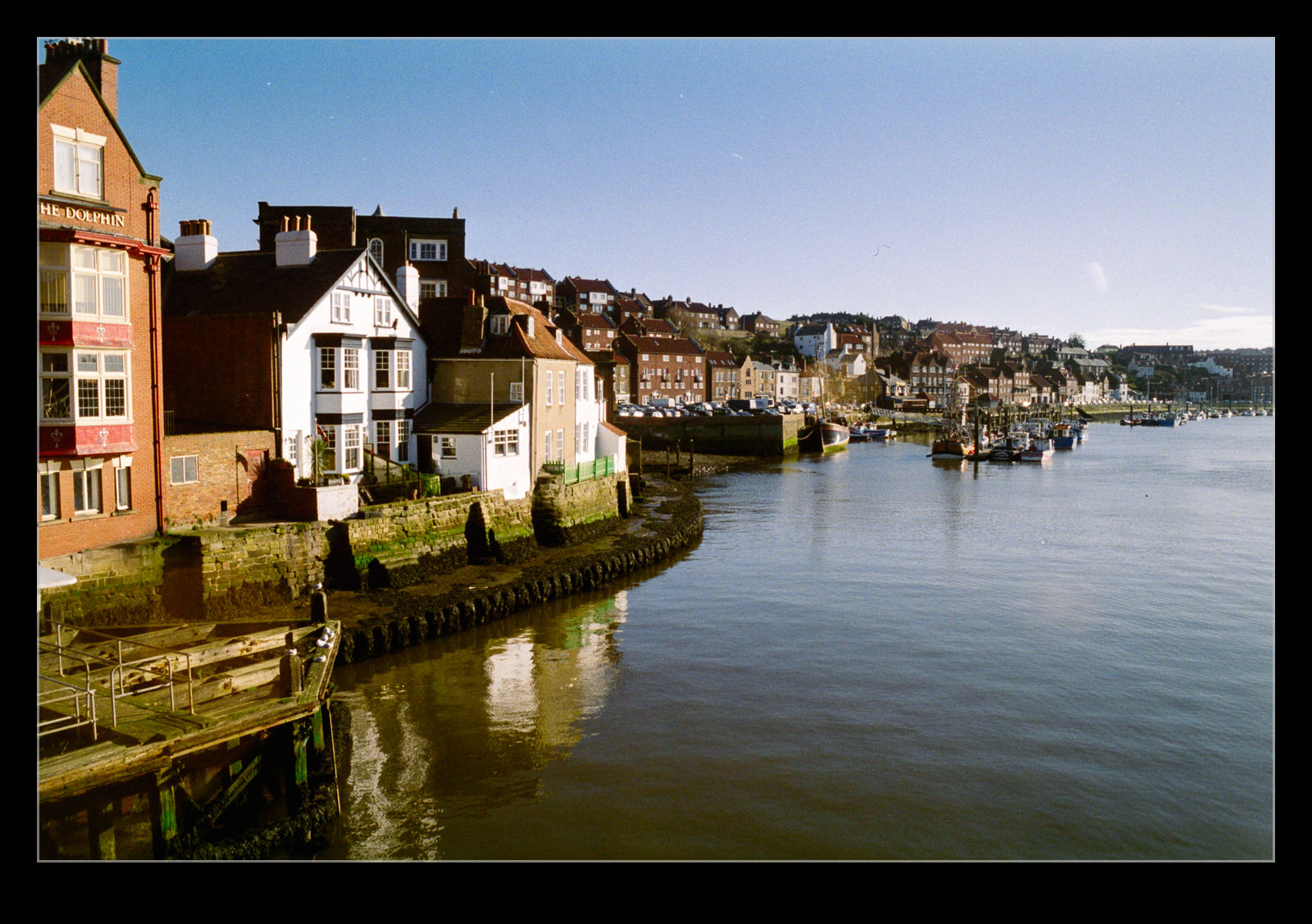 In the early 2000s, Nancy and I took a trip up to Yorkshire for a long weekend in February. We were staying in Pickering and we got there just before a decent snow storm arrived. By the time the snow started, we were comfortably tucked up in the hotel bar but the following day, any chance of going somewhere was out of the question as the town had temporarily been cut off by the snow. The day after, the roads had been cleared and we took a drive north.
In the early 2000s, Nancy and I took a trip up to Yorkshire for a long weekend in February. We were staying in Pickering and we got there just before a decent snow storm arrived. By the time the snow started, we were comfortably tucked up in the hotel bar but the following day, any chance of going somewhere was out of the question as the town had temporarily been cut off by the snow. The day after, the roads had been cleared and we took a drive north.
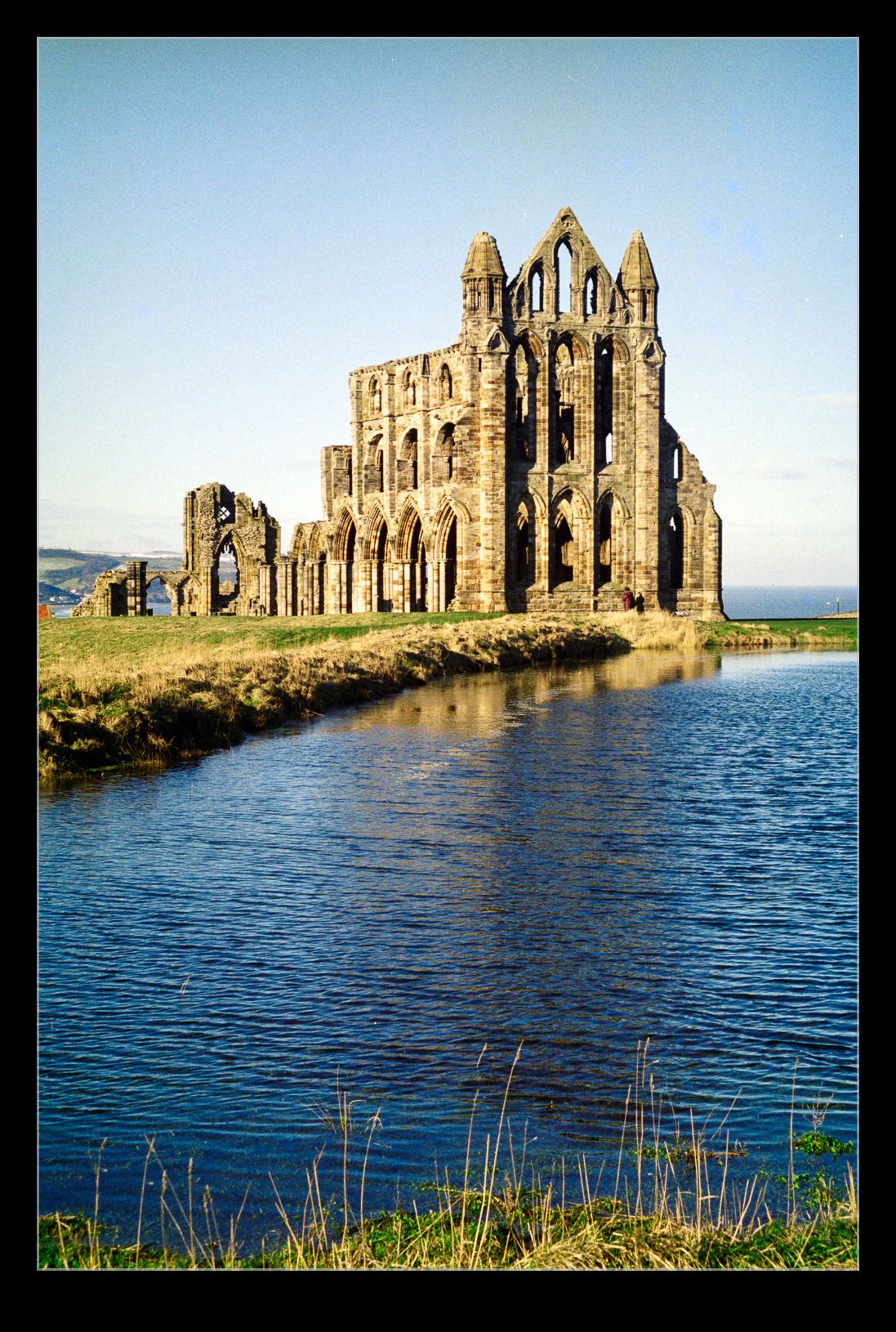 We ended up spending some time in Whitby. A historic port town, Captain James Cook first went to see from there. It has the ruins of an Abbey on the hill overlooking the harbor and the town rises from the water in a style you would expect of such an old English town to do. We went to a really nice pub for lunch as a recall where we had excellent fish and chips – formulaic I know but still bloody good! I scanned these images when making a surge through my old film shots so I thought I would go back about 20 years to something from the old country.
We ended up spending some time in Whitby. A historic port town, Captain James Cook first went to see from there. It has the ruins of an Abbey on the hill overlooking the harbor and the town rises from the water in a style you would expect of such an old English town to do. We went to a really nice pub for lunch as a recall where we had excellent fish and chips – formulaic I know but still bloody good! I scanned these images when making a surge through my old film shots so I thought I would go back about 20 years to something from the old country.
Lambs in Spring
 These two pictures are very old but they appealed to me given the time of year. They were taken in Yorkshire over 20 years ago as we were hiking in the area. It was spring and the lambing season was underway. We saw a couple of lambs gamboling through a graveyard while another was resting in the grass. Lambs in spring are such an iconic scene. With spring upon us, I felt like they should be dug out from my negative scan archive.
These two pictures are very old but they appealed to me given the time of year. They were taken in Yorkshire over 20 years ago as we were hiking in the area. It was spring and the lambing season was underway. We saw a couple of lambs gamboling through a graveyard while another was resting in the grass. Lambs in spring are such an iconic scene. With spring upon us, I felt like they should be dug out from my negative scan archive.
Ribblehead Viaduct
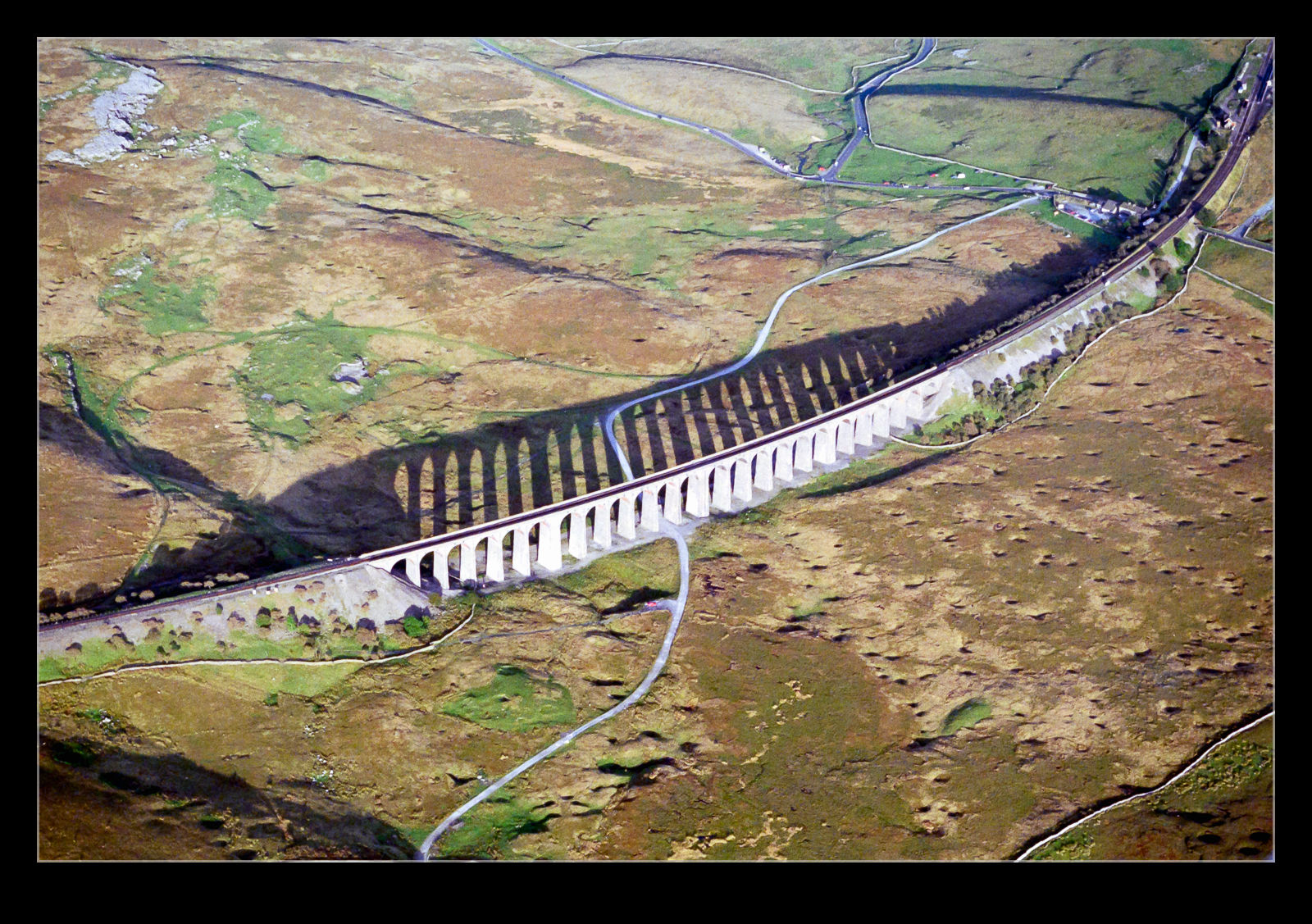 The Victorians built railways across the UK in a serious way. Geography was not a barrier and tunnels would get you through hills and viaducts would address valleys. They also liked them to look pretty cool. There are numerous viaducts across the UK – some of which are well known and others of which are rather anonymous. One of the more famous viaducts is the Ribblehead. It is part of the Settle to Carlisle line which was once lined up for closure but now seems to be secure.
The Victorians built railways across the UK in a serious way. Geography was not a barrier and tunnels would get you through hills and viaducts would address valleys. They also liked them to look pretty cool. There are numerous viaducts across the UK – some of which are well known and others of which are rather anonymous. One of the more famous viaducts is the Ribblehead. It is part of the Settle to Carlisle line which was once lined up for closure but now seems to be secure.
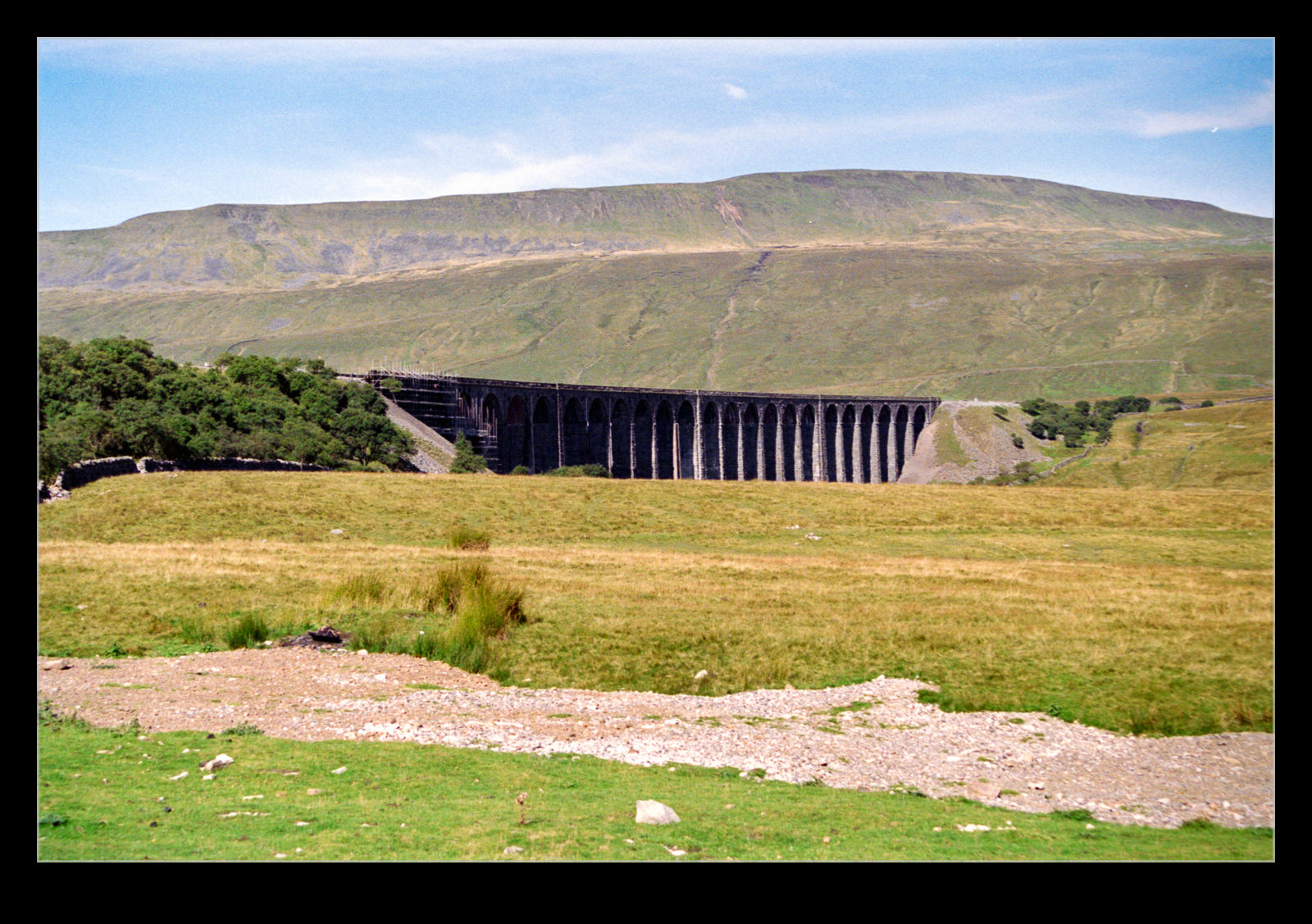 The main shot here was taken from my friend, Mark’s, Ercoupe as we had a flight from Blackpool and up over Yorkshire and Cumbria. We were flying after work so the evening light was setting in and the shadows of the viaduct were very nice. Since this was the days of film, there aren’t lots of shots to choose from. However, this one worked out well enough. Nancy and I visited the area from the ground when we lived up that way and here are a couple of additional shots of the viaduct from the ground.
The main shot here was taken from my friend, Mark’s, Ercoupe as we had a flight from Blackpool and up over Yorkshire and Cumbria. We were flying after work so the evening light was setting in and the shadows of the viaduct were very nice. Since this was the days of film, there aren’t lots of shots to choose from. However, this one worked out well enough. Nancy and I visited the area from the ground when we lived up that way and here are a couple of additional shots of the viaduct from the ground.
Malham Cove
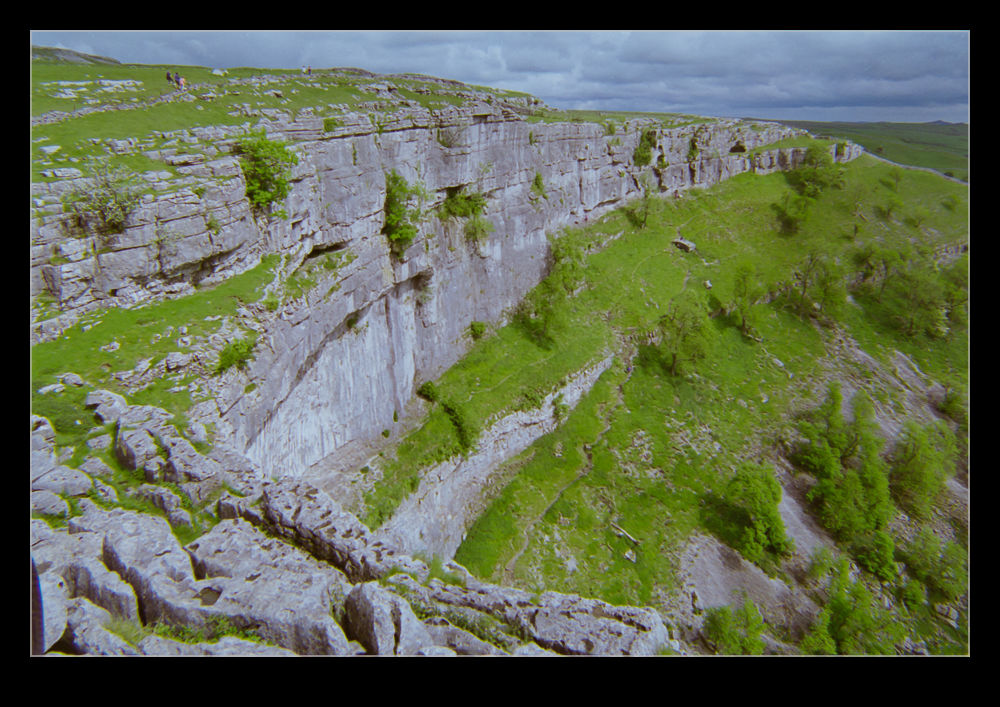 I can’t remember how the conversation developed the way it did but I was talking with a friend and got on to the subject of Malham Cove. Located in Yorkshire in the UK, this is a stunning location. It is a horseshoe shaped rock formation that once was an impressive waterfall. The water is still there but now the majority of the rock face is dry and it provides a great place for a hike. To illustrate this post, I am digging back in to the archives in a big way. This involves a trip I took there with an old friend of mine. I will not give his name but I will be interested to see if he reads this and what he thinks of photos of himself from twenty years ago!
I can’t remember how the conversation developed the way it did but I was talking with a friend and got on to the subject of Malham Cove. Located in Yorkshire in the UK, this is a stunning location. It is a horseshoe shaped rock formation that once was an impressive waterfall. The water is still there but now the majority of the rock face is dry and it provides a great place for a hike. To illustrate this post, I am digging back in to the archives in a big way. This involves a trip I took there with an old friend of mine. I will not give his name but I will be interested to see if he reads this and what he thinks of photos of himself from twenty years ago!
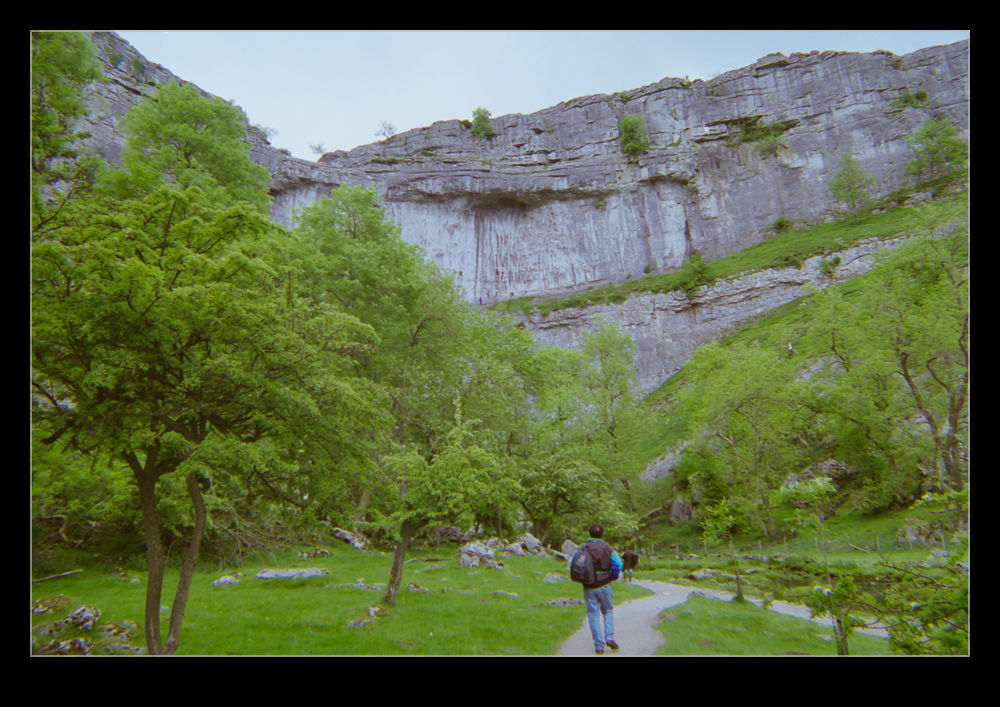 You can park your car in Malham and walk straight up to the cove. However, we took an alternative route to make for a more interesting walk. We walked up a narrow valley named Gordale Scar. The valley gets narrower and narrower until you come to a waterfall. Provided the water is not flowing too hard, it is possible to climb up the side of the waterfall. Once at the top, you continue on a steady climb alongside a river – Gordale Beck. Even as young and energetic fellows like we were in those days, I recall this being a pretty hard slog and, while neither of us was going to show weakness to the other, I seem to recall a few stops to enjoy the scenery – nothing to do with catching our breath.
You can park your car in Malham and walk straight up to the cove. However, we took an alternative route to make for a more interesting walk. We walked up a narrow valley named Gordale Scar. The valley gets narrower and narrower until you come to a waterfall. Provided the water is not flowing too hard, it is possible to climb up the side of the waterfall. Once at the top, you continue on a steady climb alongside a river – Gordale Beck. Even as young and energetic fellows like we were in those days, I recall this being a pretty hard slog and, while neither of us was going to show weakness to the other, I seem to recall a few stops to enjoy the scenery – nothing to do with catching our breath.
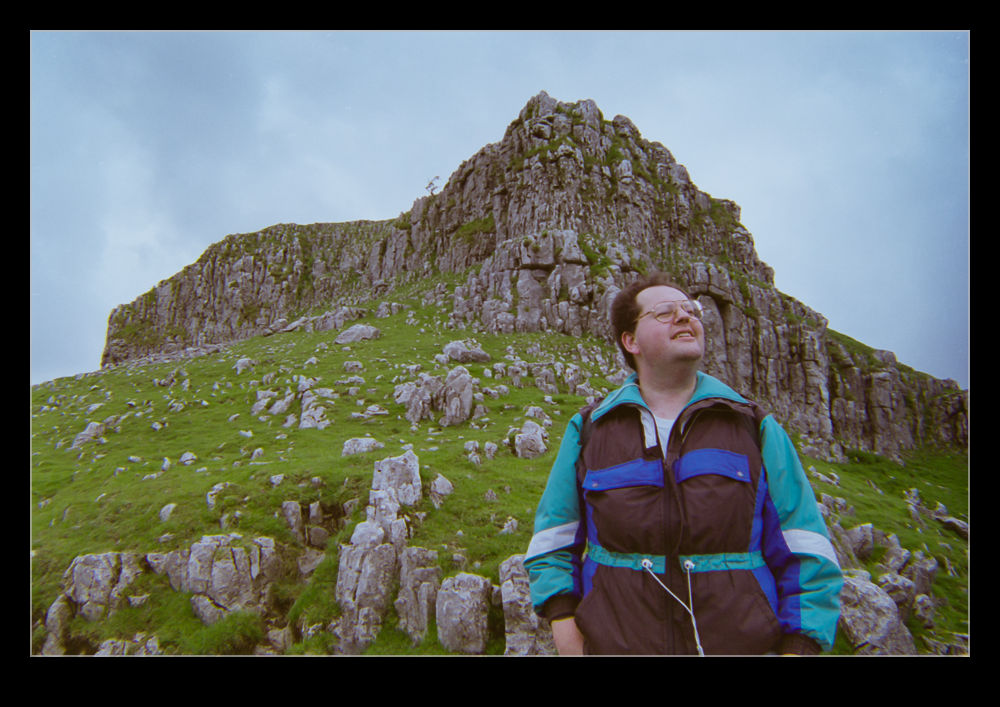 Things gradually flatten out and you cross some fields to come to Malham Tarn, a moderately sized lake. This is the turning point for the walk. Now you head back towards Malham itself. You end up coming across a limestone pavement to the tome of Malham Cove. Here you will meet a bunch of people that have walked up the steps from the valley below. Having made a far longer trek, you are tempted to be a little dismissive of these people taking the easy route but there are still a lot of steps so they have had to make some effort.
Things gradually flatten out and you cross some fields to come to Malham Tarn, a moderately sized lake. This is the turning point for the walk. Now you head back towards Malham itself. You end up coming across a limestone pavement to the tome of Malham Cove. Here you will meet a bunch of people that have walked up the steps from the valley below. Having made a far longer trek, you are tempted to be a little dismissive of these people taking the easy route but there are still a lot of steps so they have had to make some effort.
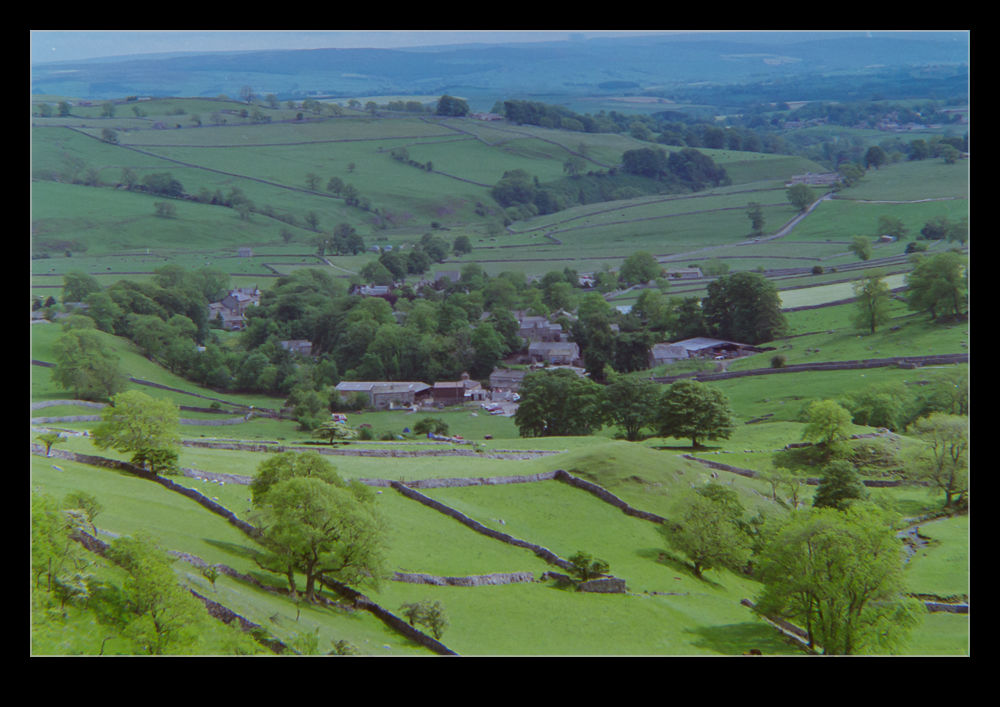 The view from the top is stunning. The drop down is a long one – about 80m (240’) – and there are often climbers testing themselves against the rock faces. The cracks in the limestone can be quite large as you step across and it is fun to imagine the whole thing being under rushing water. The formation is about 300m wide so, while it might be busy, you probably won’t feel crowded. When you have finally enjoyed the scenery enough, you can descend the steps at the side to head back into the village. This still gives you a chance to appreciate the view back up at the cove as you head away.
The view from the top is stunning. The drop down is a long one – about 80m (240’) – and there are often climbers testing themselves against the rock faces. The cracks in the limestone can be quite large as you step across and it is fun to imagine the whole thing being under rushing water. The formation is about 300m wide so, while it might be busy, you probably won’t feel crowded. When you have finally enjoyed the scenery enough, you can descend the steps at the side to head back into the village. This still gives you a chance to appreciate the view back up at the cove as you head away.
This place is stunning, particularly on a lovely day. If you live in the UK and have never been, try and get there. If you don’t live in the UK, add this to your itinerary when you go.













